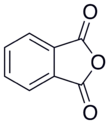Phthalic anhydride
Agent Name
Phthalic anhydride
CAS Number
85-44-9
Formula
C8-H4-O3
Major Category
Plastics & Rubber

Synonyms
1,2-Benzenedicarboxylic anhydride; PAN; Phthalic acid anhydride; [NIOSH]
Category
Acid Anhydrides, Cyclic
Description
White solid (flake) or a clear, colorless, mobile liquid (molten) with a characteristic, acrid odor; [NIOSH]
Sources/Uses
Chemical intermediate for various chemical resins, dyes, and pigments; curing agent for epoxy resins; [HSDB] Occupational asthma reported in plastic resin production workers; [Malo] Used to make alkyd resins in the production of paints; Workers may be exposed while welding on painted metals containing alkyd resin with phthalic anhydride hardener; [ACGIH]
Comments
Occupational asthma reported in plastic resin production workers; [Malo] Solid form causes first degree burns on short exposure; [CHRIS] Phthalic anhydride is a skin irritant. [Quick CPC] "Workers exhibiting dermal or respiratory symptoms (e.g., rhinitis) may benefit from early intervention to reduce or eliminate further exposure. . . . A number of human studies found that phthalic anhydride exposure can cause or is associated with sensitization, elevated IgE and IgG, occupational asthma (immediate, late or both), rhinitis, conjunctivitis, chronic bronchitis, respiratory irritation, and contact urticaria. It may also cause allergic contact dermatitis." [ACGIH] See "ACID ANHYDRIDES."
Reference Link #1
Biomedical References
Exposure Assessment
Skin Designation (ACGIH)
Yes
TLV (ACGIH)
0.002 mg/m3, inhalable fraction and vapor (Surface Level = 0.05 mg/cm2)
STEL (ACGIH)
0.005 mg/m3, inhalable fraction and vapor
PEL (OSHA)
12 mg/m3
IDLH (NIOSH)
60 mg/m3
Excerpts from Documentation for IDLHs
Other animal data: It has been reported that exposure of rats and rabbits to 10,000 mg/m3 for 4 hours/day for several days produced a 25% fatality rate [Malten and Zielhuis 1964]. Human data: It has been reported that an exposure of 30 mg/m3 is associated with conjunctivitis, while 25 mg/m3 is associated with signs of mucous membrane irritation [Baader 1955]. It has been stated that phthalic anhydride has similar toxic effects (i.e., irritation of the skin, eyes, and upper respiratory system) as maleic anhydride, but has reduced potency [ACGIH 1991].
Vapor Pressure
0.000517 mm Hg
Odor Threshold Low
0.05 ppm
Explanatory Notes
Odor threshold from AIHA; VP from HSDB;
Reference Link #2
NFPA
must be preheated
Adverse Effects
Skin Sensitizer
Yes
Asthma
Yes
Dermatotoxin
Skin burns
ACGIH Carcinogen
Not Classifiable
Diseases, Processes, and Activities Linked to This Agent
Diseases
Occupational diseases associated with exposure to this agent:
Processes
Industrial Processes with risk of exposure: